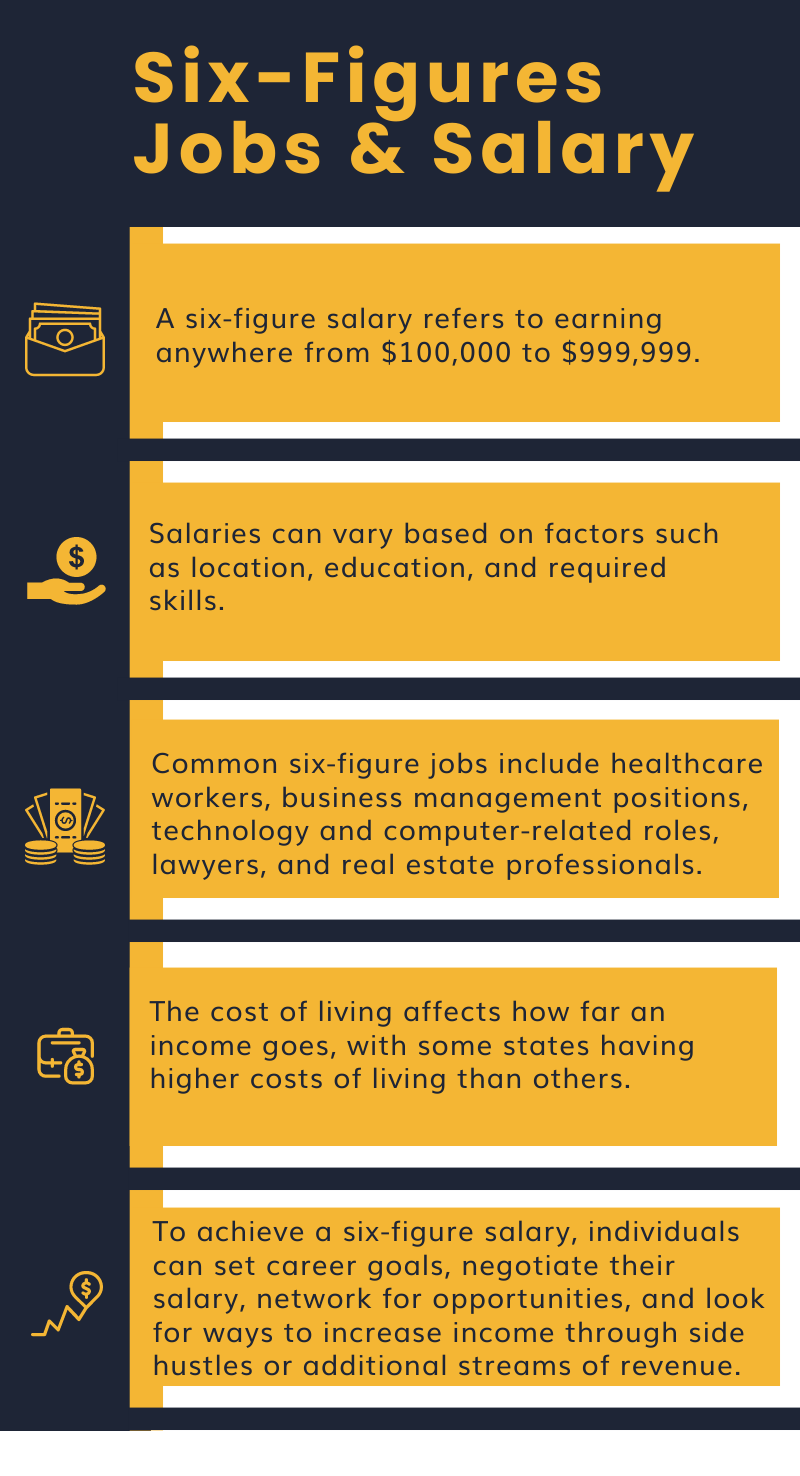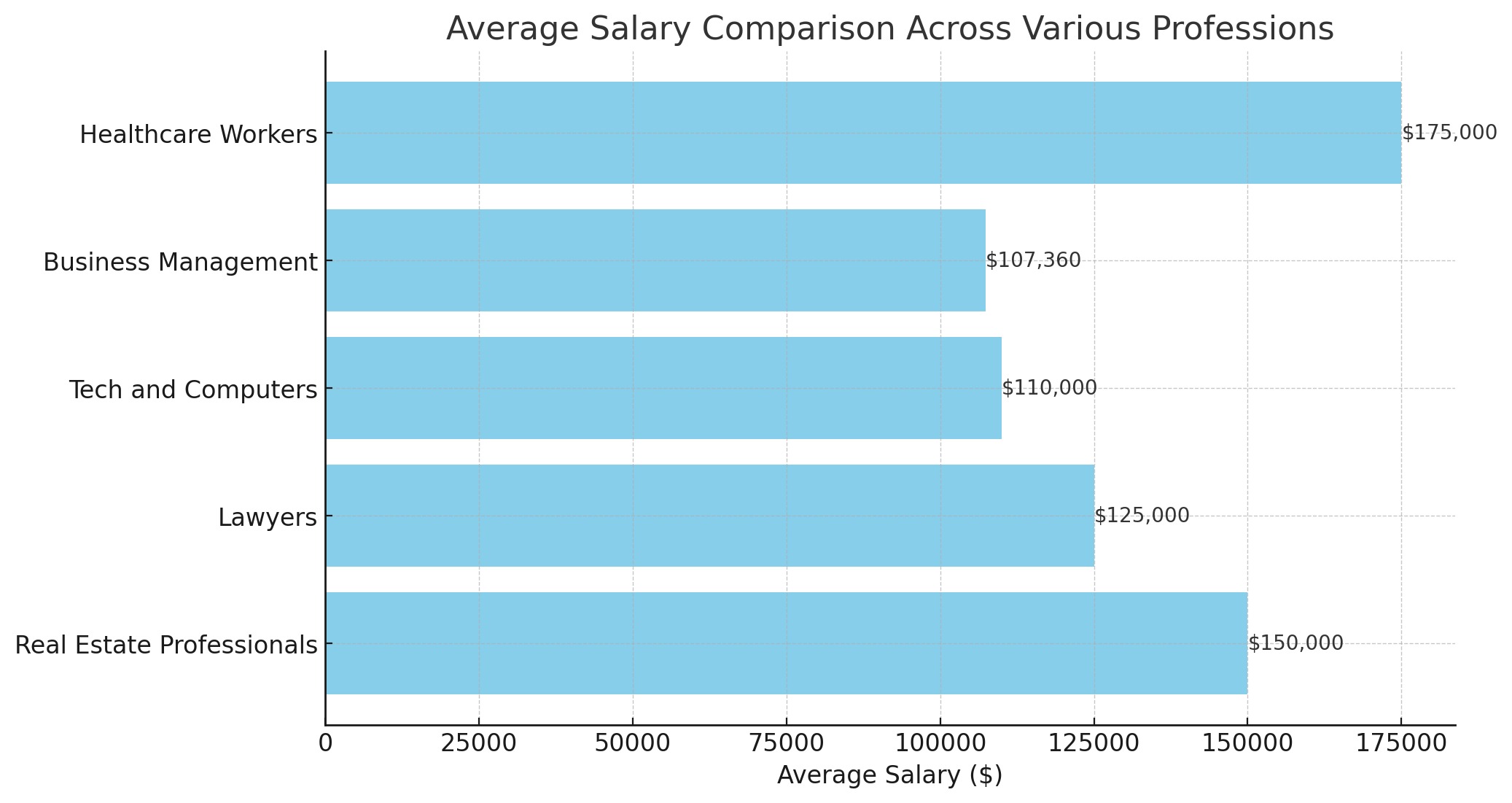Did you know that a six-figure salary ranges from $100,000 to $999,999? That’s right! This impressive salary range consists of every number in this range having six digits. Salaries in this range can vary depending on factors such as location, education, and required skills.

Common Six-Figure Jobs
When it comes to common six-figure jobs, there are several fields that offer lucrative salaries. Let’s explore some of these high-paying careers:
Healthcare Workers
Healthcare professionals such as doctors, dentists, physician assistants, and pharmacists often earn impressive salaries in the range of $120,000 to $230,000 per year. These well-respected individuals play a crucial role in ensuring the well-being of others while enjoying a rewarding income.
Business Management Positions

In the field of business management, positions in finance, marketing, accounting, operations, and sales can command a median salary of $107,360. These versatile roles require strong leadership skills and a deep understanding of business strategies, making them highly sought after in various industries.
Technology and Computer-Related Roles
In the fast-paced world of technology, professionals with in-demand skills can earn impressive six-figure salaries. Roles such as software engineers, data scientists, and systems analysts often make between $80,000 to $140,000 annually. With technology driving innovation across industries, these positions offer both financial stability and exciting career opportunities.
Lawyers

Lawyers, with their specialized knowledge of the legal realm, have the potential to earn significant incomes. Depending on their area of expertise, lawyers typically make around $100,000 to $150,000 per year. This profession demands expertise, dedication, and a commitment to justice.
Real Estate Professionals
The real estate industry offers a wide range of salary potential to professionals. From real estate agents to property managers, the income can vary greatly, depending on factors such as location, experience, and sales performance. Annual salaries for real estate professionals can range from $50,000 to $250,000 through commissions on sales.
These are just a few examples of jobs in various industries. The key is to identify one’s passion, strengths, and qualifications to embark on a fulfilling career journey that leads to financial success.

Note: Salaries mentioned are average ranges and may vary based on factors such as experience, education, location, and industry. It’s important to conduct thorough research and consult reliable sources for up-to-date salary information.
Breaking Down a Six-Figure Salary
A six-figure salary can be an attractive prospect, offering financial stability and the ability to live comfortably. However, it is important to understand how this salary is broken down to truly grasp its value. Let’s take a closer look at the monthly and yearly earnings of a six-figure salary, as well as the impact of the cost of living.
The Breakdown
When we talk about a six-figure salary, we typically refer to an annual income ranging from $100,000 to $999,999. To get a better idea of how this breaks down on a monthly basis, let’s consider a few examples:
| Salary Range | Monthly Earnings |
|---|---|
| $100,000 | $8,333.33 |
| $250,000 | $20,833.33 |
| $500,000 | $41,666.67 |
As you can see, a six-figure salary offers a significant monthly income that allows for financial flexibility and the ability to meet various financial goals and obligations.
The Impact of Cost of Living

While a six-figure salary may seem substantial, it’s important to consider the cost of living as well. The cost of housing, food, transportation, and other living expenses can vary greatly depending on the location. For instance, cities like Washington, D.C. and New York City are known for their higher costs of living compared to areas like Dallas, Texas.
To truly assess the value of a six-figure salary, one must take into account how far that income goes in a specific location. It’s crucial to consider the cost of housing in desirable neighborhoods, the average cost of groceries and dining out, commuting expenses, healthcare costs, and other factors relevant to the chosen area of residence.
Understanding the cost of living ensures that individuals can make informed financial decisions and manage their income effectively.
In conclusion, breaking down a six-figure salary provides insights into its monthly and yearly earnings, empowering individuals to assess their financial standing. By considering the cost of living, individuals can make informed decisions about their housing, transportation, and other expenses, ensuring a balanced approach to financial planning.
Remember, a six-figure salary offers significant earning potential, but it’s essential to account for the impact of the cost of living to fully leverage its benefits.
Tips for Achieving a Six-Figure Salary

To achieve a six-figure salary, individuals can start by setting both short-term and long-term career goals. By planning their professional journey, they can create a clear path towards success and take the necessary steps to reach their desired income level.
Whether it’s obtaining higher education, acquiring specialized skills, or acquiring relevant certifications, setting career goals can help individuals progress towards earning a six-figure salary.
Another essential aspect of achieving a six-figure salary is salary negotiation. When receiving a new job offer or promotion, individuals should not shy away from negotiating their salary.
Researching industry standards, understanding the value of their skills, and showcasing their accomplishments can help in demonstrating their worth to potential employers. Negotiating salaries can be a powerful strategy for increasing earnings and taking a step closer to a six-figure income.
In addition to salary negotiation, networking plays a crucial role in career advancement and earning potential. Building a professional network can open doors to higher-paying positions, as well as provide access to valuable opportunities for growth and development.
Active participation in industry events, joining professional organizations, and leveraging online platforms can help individuals expand their network and increase their chances of finding lucrative opportunities.
Furthermore, creating multiple income streams can significantly contribute to achieving a six-figure salary. In addition to a primary job, individuals can explore side hustles or invest in ventures like real estate, stocks, or online businesses.
Diversifying income sources not only boosts overall earnings but also provides financial security and stability. By developing financial literacy skills and making informed decisions about saving, investing, and spending, individuals can maximize their income potential and secure long-term financial success.
FAQ
What defines a six-figure salary?
A six-figure salary refers to an annual income that ranges from $100,000 to $999,999. Each figure in this range comprises six digits, indicating substantial earning potential across various professions.
Which professions commonly offer six-figure salaries?
Professions that often feature six-figure salaries include healthcare roles like doctors and pharmacists, business management positions such as financial and operations managers, technology and computer-related jobs like software engineers, legal professionals such as lawyers, and real estate agents or managers depending on sales performance.
How does the cost of living affect the value of a six-figure salary?
The real value of a six-figure salary can vary significantly depending on the cost of living in a particular area. High-cost areas like New York City may require a higher income to maintain the same standard of living as in lower-cost areas like Dallas, Texas. It’s important to consider expenses such as housing, transportation, and food, which can greatly impact how far a six-figure income stretches.
What are some tips for achieving a six-figure salary?
Achieving a six-figure salary typically involves a combination of education, skill acquisition, and career planning. Key strategies include setting clear professional goals, obtaining relevant higher education or certifications, excelling in high-demand fields, negotiating salaries effectively, networking within the industry, and possibly developing multiple streams of income to enhance overall earnings.


